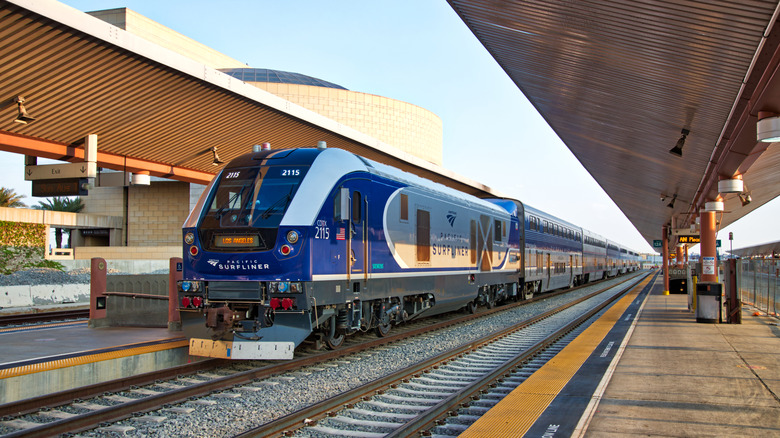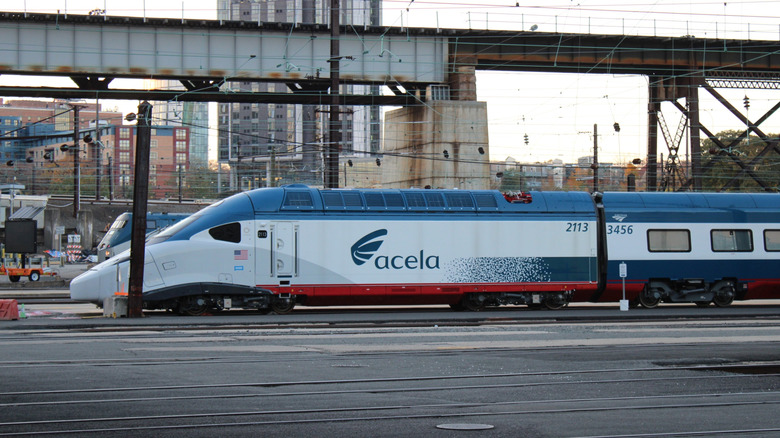How Fast Do Amtrak Trains Go? A Look At Their Top Speed
When America's first railroad, the Baltimore & Ohio line, opened in 1830, it was the first thread in a web that would span a continent. What began as a modest 14 miles of track between Baltimore and Ellicott, MD, has grown into the largest rail network in the world with a staggering 136,729 miles of railway line. However, the adage quantity over quality applies here and while it may be the biggest network, a lack of infrastructure investment, curvy tracks, and traffic have all left U.S. railroads comparing badly against many nations. At least, in terms of speed.
When Japan's Shinkansen "bullet train" debuted between Tokyo and Osaka in 1964, it set new benchmarks, hitting speeds of 130 mph. Fast-forward sixty years, and the current generation can hit 200 mph. Other countries' railroads can also boast some pretty impressive speed stats, including France's TGV which regularly runs at 199 mph, with a heavily modified version hitting a breathtaking 357 mph. Other countries with trains that regularly approach or exceed 200 mph include Morocco, Germany, China, and Spain. By comparison, America's fastest passenger train, Amtrak's Acela, can currently reach speeds of a more modest 150 mph, with the next Acela generation capable of speeds of up to 186 mph, although it is unlikely to reach speeds of more than 160 mph when operating commercially. Though impressive within the U.S., Acela's speed remains modest compared to international standards.
Why America's passenger trains are slower than you think
Given that America built its first railroad nearly two centuries ago, it might seem surprising that U.S. trains lag behind their global counterparts when it comes to speed. The reasons aren't hard to find, though. The country's existing railroad infrastructure, much of it dating back to the 19th century, wasn't designed with high-speed travel in mind. Railways were often laid out to follow existing terrain and property lines, creating curvy tracks that prevent trains from reaching maximum speeds.
This is a situation that will only improve with the right investment. As Amtrak CEO Stephen Gardner noted during an interview with Fortune Magazine, "It's a financial conversation, not a technical one. There's not a technical barrier to building high-speed rail. But what you need is political and financial alignment to make the investment." To get an idea of the scale of the problem, we can consider the $66 billion investment earmarked for rail infrastructure in 2021. This pales in comparison to the $4 trillion estimated to be needed to build a U.S.-wide high-speed railroad network. A testament to how far America's trains have to travel to achieve speeds considered normal in the rest of the world can be obtained by looking at the fastest-ever speed achieved on American railroads. The record was set by the appropriately named TurboTrain, which achieved 170.8 mph on December 20, 1967. For comparison, several scheduled routes in China have top speeds of 217 mph, making it home to some of the world's fastest trains.
America's fastest rail journeys
American trains may not match the speeds of international equivalents, but some routes still offer genuinely fast and enjoyable rail journeys. For speed seekers, the fastest journey in America can be found on the Northeast Corridor mainline. The 457-mile line runs from Washington, DC to Boston, MA, and the current generation of Acela trains achieve speeds of 150 mph in New Jersey, Rhode Island, and Connecticut. The next generation of Acela trains will be able to hit a top speed of 160 mph on the New Jersey high-speed stretch. Another high-speed option is Florida's Brightline train. The Brightline journey between Cocoa and Orlando International Airport tops out at 125 mph, although 130 mph was achieved during testing.
The Northeast Regional Line also achieves speeds of up to 125 mph. The 682-mile line runs from Boston, MA to Roanoke, VA, although the top speed is only achieved in a few spots where the track is straight enough to allow it. While these speeds are nothing to write home about in a global context, they're the current best America has to offer. However, for high-speed train enthusiasts, the good news is that a true American high-speed performance is in the offing. Two segments of a high-speed line between Los Angeles and San Francisco are currently being constructed, with the ultimate aim of making 220 mph rail travel in the U.S. a reality. Hopefully, it will be the first of many such projects.


